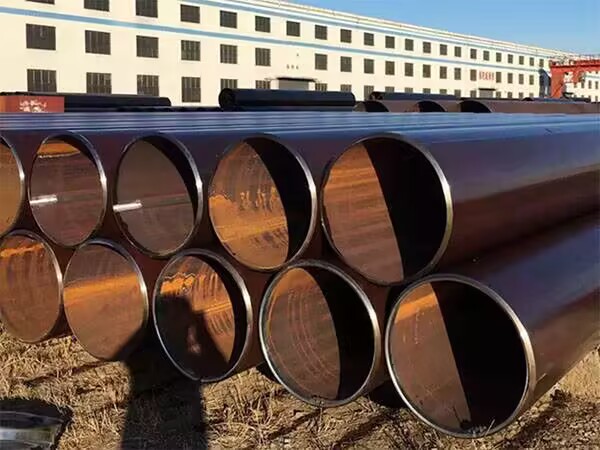Welding process of straight seam steel pipe
Straight seam steel pipe is a kind of steel pipe formed by rolling steel strip or steel plate into a tube at a certain Angle, and then welding the two ends through the linear welding technology. Straight steel pipe is widely used in oil, natural gas, electric power, chemical industry and other fields, especially suitable for high pressure, high temperature conditions of the pipeline. The welding process of straight seam steel pipe plays an important role in its quality, pressure resistance, corrosion resistance and so on. The following is the basic flow and key points of the straight seam steel pipe welding process.

In the selection of welding materials, it is necessary to select steel plates or steel belts that meet the standards, and the commonly used materials are carbon steel and alloy steel such as Q235 and Q345. Before welding, it is necessary to thoroughly remove oil, rust, oxide and other pollutants on the surface of the steel pipe to avoid affecting the quality of welding. The cleaning can use mechanical grinding, pickling, sandblasting and other methods.
Common welding process
The common welding methods of straight pipe include arc welding, CO2 shielded welding, submerged arc welding, etc. The selection of welding method mainly considers the use of the pipe, pressure grade, pipe wall thickness and welding process requirements.
Submerged arc welding: suitable for large diameter steel pipe, with high welding efficiency, to ensure the quality of the weld, welding using automatic equipment to control arc stability, suitable for thick wall steel pipe welding. In the welding process, the flux diffuses at the front end of the arc through the funnel, and the flux can be recovered automatically or manually cleaned by the flux recovery device if it is not melted after welding.
CO2 protection welding: suitable for small and medium-sized diameter steel pipe, the welding process is more stable, easy to control the welding heat input, to ensure small deformation, suitable for the appearance of the welding requirements.
Arc welding: Mainly used for small diameter pipes and maintenance operations, suitable for on-site welding.
Resistance welding: Resistance welding is to apply a current to the workpiece through the electrode, so that the contact surface and the area near it generate heat due to resistance. Heat heats the material to a state of melting or near melting, and then binds it together under pressure. The core of the welding process is to control the generation and transfer of heat. The welding speed of resistance welding is fast and suitable for mass production.
Parameter setting during welding
According to different welding methods and pipe materials, choosing the right welding parameters is the key to ensure the welding quality. The main welding parameters include:
Current and voltage: Welding current and voltage need to be adjusted according to the thickness of the steel pipe, material and welding method.
Welding speed: Welding speed directly affects the forming quality of the weld, too fast may lead to incomplete welding, too slow may produce welding defects, such as overburning, cracks, etc.
Heat input control: Reasonable control of heat input can reduce welding deformation and internal defects.
Quality control during welding
Welding sequence: The appropriate welding sequence should be selected to control welding deformation and avoid bending of the pipeline due to asymmetric heating. Common welding sequences include "butt joint" welding and "step welding".
Weld inspection: After the welding is completed, the necessary weld inspection, such as X-ray or ultrasonic inspection, should be carried out to check for internal defects.
Appearance inspection: Check the appearance of the welded joint to ensure that the weld is smooth, no obvious porosity, cracks, slag and other defects.
Post-welding treatment
Heat treatment: For large caliber or thick wall steel pipes, post-welding heat treatment, such as annealing, normalizing or slow cooling treatment, can be carried out to eliminate welding stress and improve the performance of the weld.
Surface treatment: The welded steel pipe may have oxide or other impurities, which need to be removed by pickling, sandblasting and other methods to improve the corrosion resistance of the pipeline.
Welding defects and solutions
Porosity: Usually caused by insufficient protective gas during welding or excessive humidity in the welding environment. The solution is to ensure sufficient protective gas flow and keep the welding environment dry.
Cracks: Cracks may occur due to excessive heat input, excessive welding cooling, or improper welding sequence. The welding heat input should be controlled and the appropriate welding materials and processes should be selected.
Lack of penetration: If the welding current is too small and the welding speed is too fast, insufficient penetration may occur. Parameters should be adjusted according to welding process requirements to ensure welding penetration.
Quality check after welding
After the welding is completed, in addition to the conventional appearance inspection and dimensional inspection, the following quality acceptance needs to be carried out:
X-ray or ultrasonic testing: Non-destructive testing of the weld to ensure that the weld is free of internal defects and meets pressure requirements.
Mechanical properties test: such as tensile test, bending test, etc., to ensure that the weld has sufficient strength and toughness.
Corrosion resistance test: For steel pipes used in corrosive environments, corrosion resistance testing is required to ensure the corrosion resistance of welded joints.
Summary
The welding process of straight seam steel pipe is an important link to ensure the quality and safety of steel pipe. Through scientific selection of welding methods, optimization of welding parameters, strict control of quality factors in the welding process, and necessary post-welding treatment, welding defects can be effectively avoided to ensure that the steel pipe has good mechanical properties and long-term service life. In actual engineering, the welding process should be adjusted according to the specific application scenarios to ensure the reliability of the steel pipe in complex environments such as high pressure, high temperature, and corrosion.
